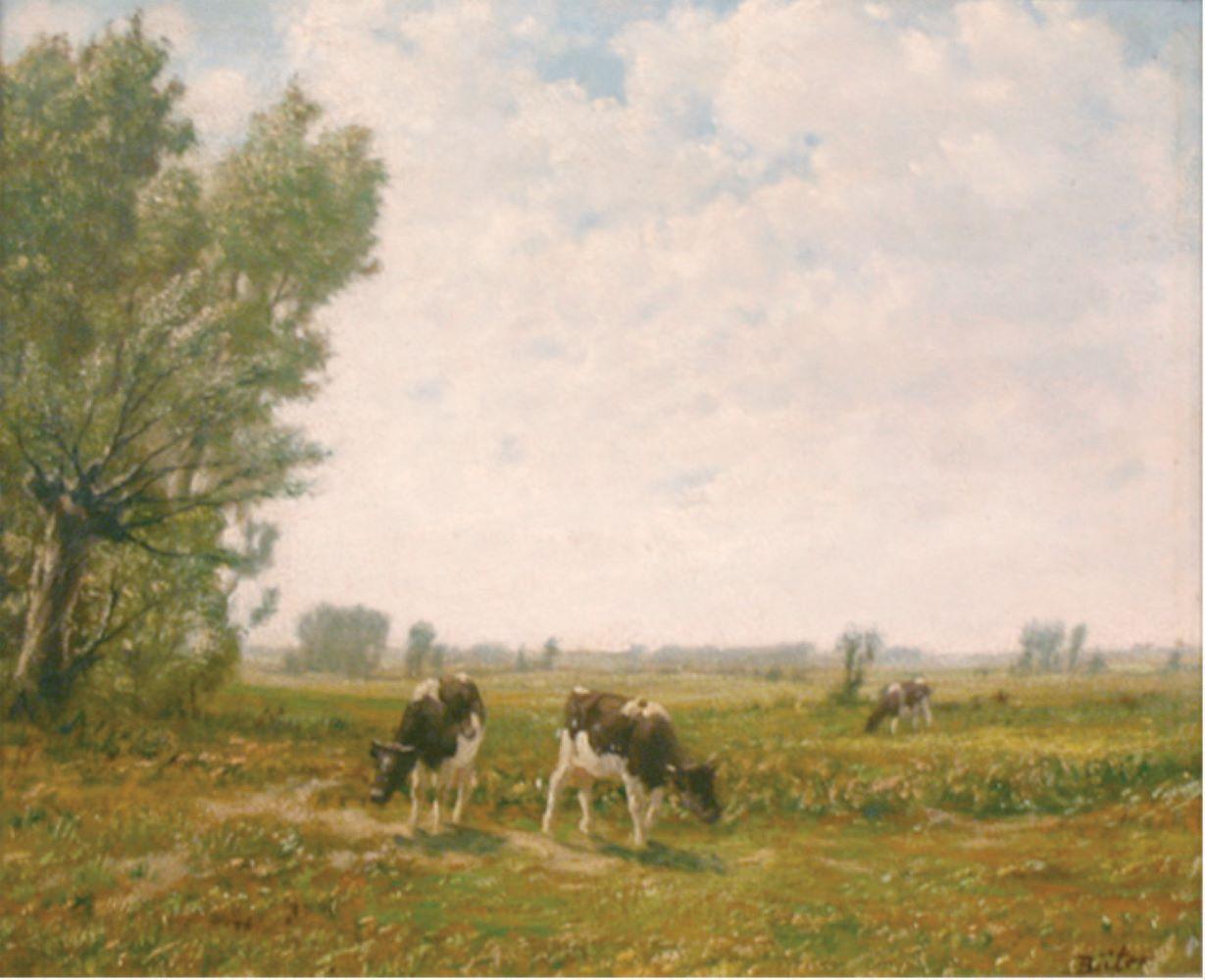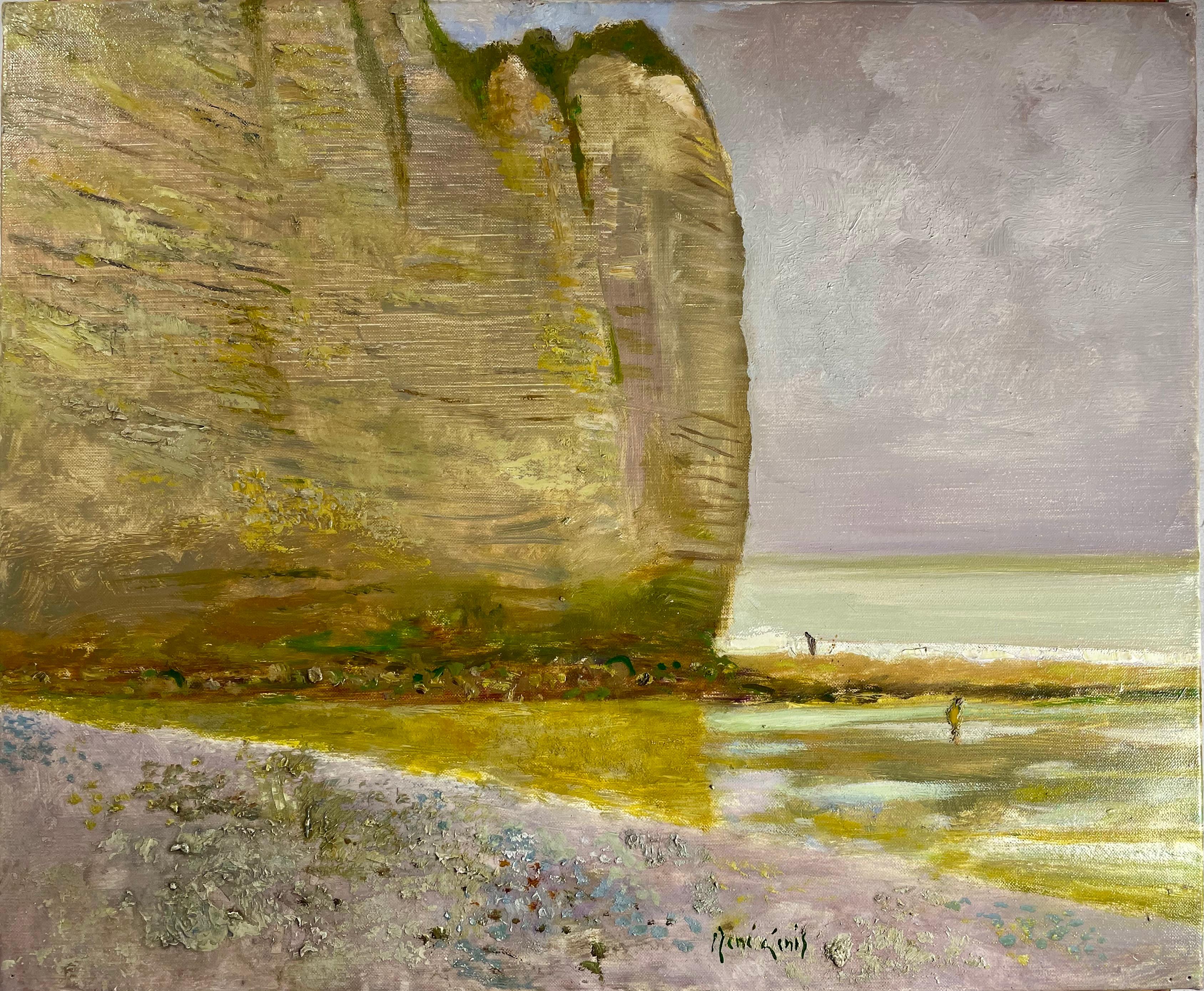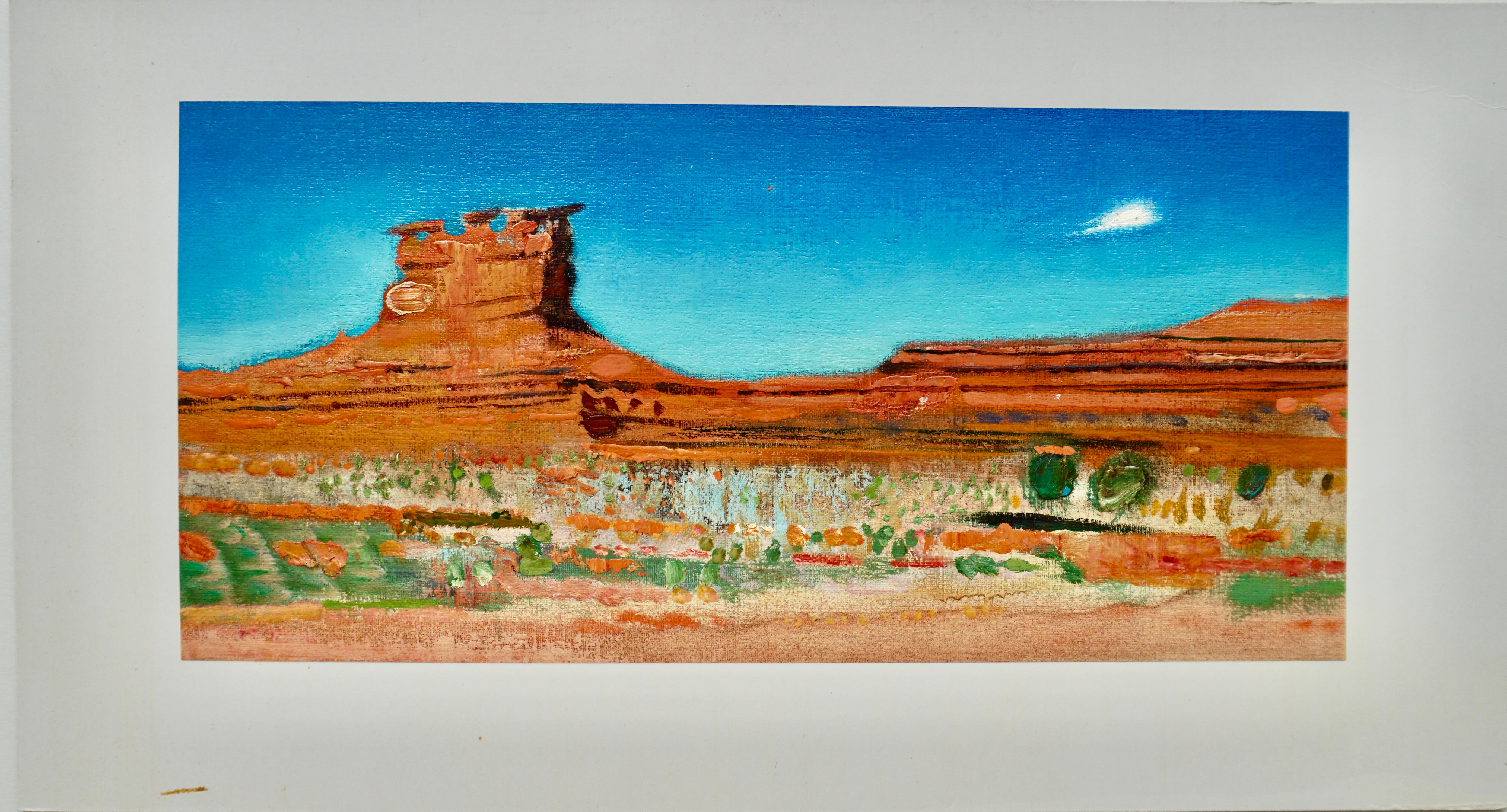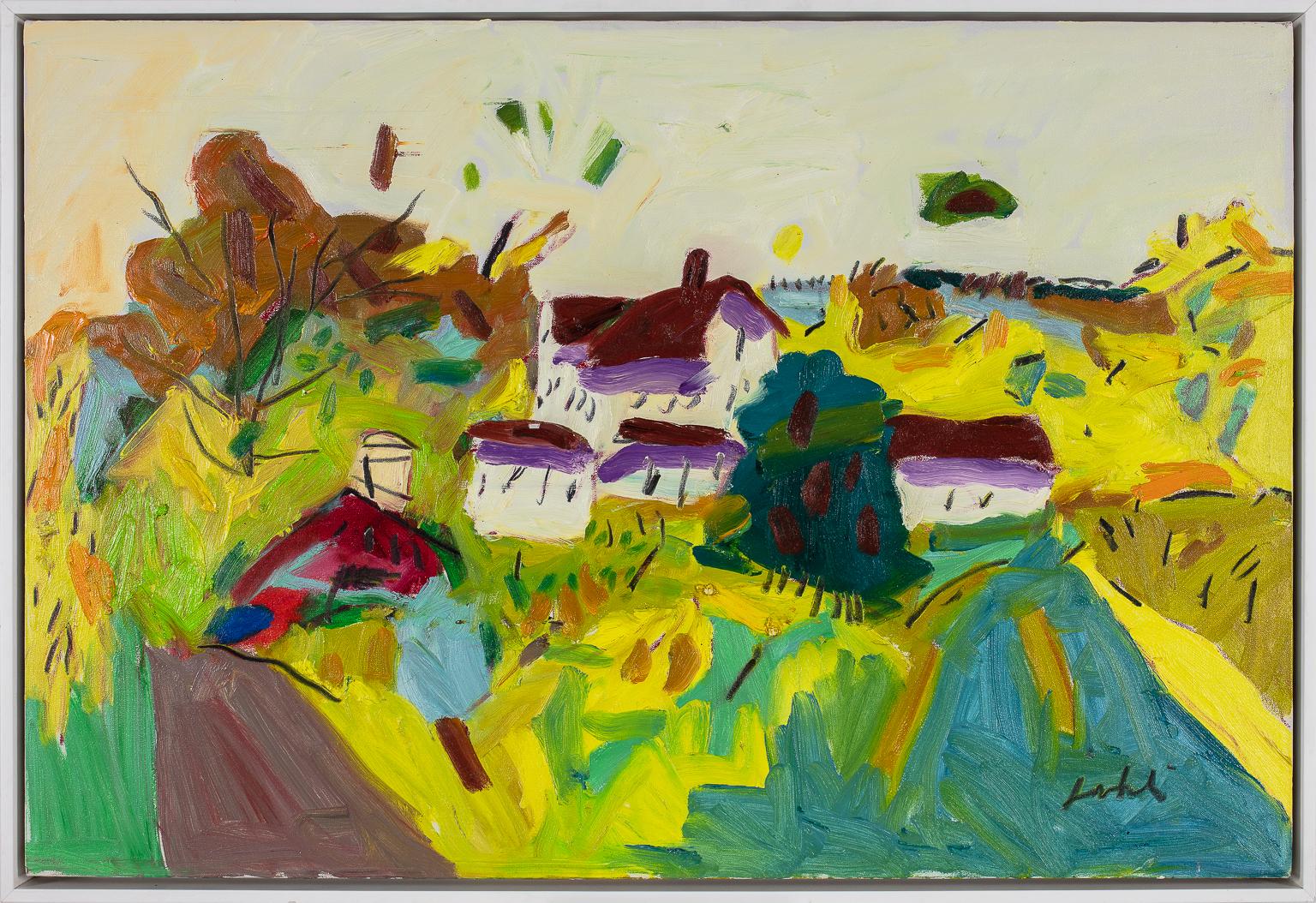Items Similar to Thomas M Nicholas Winter Country Scene Northeast Oil
Want more images or videos?
Request additional images or videos from the seller
1 of 12
T. M. NicholasThomas M Nicholas Winter Country Scene Northeast Oil
About the Item
SALE ONE WEEK ONLY
The untitled oil painting of a quiet country winter scene is a typical subject matter for T. M. Nicholas who is considered by many to be among the most prominent painter of his generation and specifically of the Rockport School of Art. Painting is signed in the lower right front corner.
He grew up admiring the rugged beauty of the U.S. northeast coastline especially the landscapes of coastal New England. His father, esteemed painter, Tom Nicholas, offered advice helping T.M. develop his own individualistic style to become the plein-air painter he is today. The painting is signed on the lower right.
T.M. Nichols was born in Rockport, Massachusetts in 1963 and is the son of Tom Nicholas, NA, AWS. In addition to studying with his father, T. M. also studied under John Charles Terelak at the Gloucester Academy of Fine Arts and the Boston area artist George Gabin at Monserrat School of Art. The area of emphasis was on realistic paintings and drawing. He attended workshops with noted California artists, Jade Fon, Morris Shubin, Millard Sheets and George Gibson. He has received numerous awards from 1981 to the present, including several Gold and Silver medals.
He is a member of the Rockport Art Association, the Guild of Boston Artists, Whiskey Painters of America, Hudson Valley Artists, Allied Artists of America, Academic Artists, American Artists Professional League, New England Watercolor Society, and the North Shore Arts Association. His paintings are in many museum, corporate, and private collections throughout the country.
He resides in Essex, Massachusetts.
Unframed the piece measures 14 x 20
- Creator:T. M. Nicholas
- Dimensions:Height: 18 in (45.72 cm)Width: 24 in (60.96 cm)
- Medium:
- Period:
- Condition:
- Gallery Location:Detroit, MI
- Reference Number:1stDibs: LU1286112745242
About the Seller
5.0
Gold Seller
These expertly vetted sellers are highly rated and consistently exceed customer expectations.
Established in 2014
1stDibs seller since 2019
95 sales on 1stDibs
Typical response time: 3 hours
- ShippingRetrieving quote...Ships From: Detroit, MI
- Return PolicyA return for this item may be initiated within 14 days of delivery.
More From This SellerView All
- Henry Wallace Methven "Impressionist Landscape" Water, Trees Summer ReflectionLocated in Detroit, MISALE ONE WEEK ONLY Impressionist Landscape" is an exquisitely peaceful late summer scene along the banks of a quiet river. The dappling yellow and green leaves and the spots of blue sky give the perfect impressionistic feel to the scene. Impressionism was a style or movement in painting originating in France in the 1860s, characterized by a concern with depicting the visual impression of the moment, especially in terms of the shifting effect of light and color. Methven captured this impression perfectly. It is as fresh today as when it was painted in 1902 so much so that you can almost hear the rustle of the leaves and see the shifting light. The gold gilt frame is original to the piece. Without the frame the piece measures 20 h x 16 w. It is signed by the artist. Methven was born in Philadelphia, Pennsylvania. In the 1930's he moved to Chicago, Illinois, where he painted with other area Chicago artists and showed at The Art Institute of Chicago. He spent his summers in Benton Harbor, Michigan, along Lake Michigan. He is known for his landscapes and water scenes. Michigan has numerous rivers, creeks and small lakes and Methven would have had a wealth of scenes to draw upon for his numerous oil paintings. He studied under Henry Fenton Spread who taught at the School of the Art Institute of Chicago and later founded Spread's Art Academy. In 1902, this academy became the Chicago Academy of Fine Arts. Spread was named the first president of the Chicago Society of Artists in 1889. Known primarily as a portraitist, Spread also painted landscape and genre scenes. Although a skilled artist, he did not exhibit widely; his primary legacy being fostering a love of art in Chicago. Fellow artist (and former student of Spread), Ralph Clarkson, the noted Chicago society portrait painter, stated that Spread' s "fine and advice formed the careers of the men who were not only to achieve prominence as artists, but to occupy leading places as art teachers". Harry Wallace Methven...Category
Early 1900s Impressionist Landscape Paintings
MaterialsCanvas, Oil
- "Study of Mt. Vesuvius" Oil on Canvas, Blue Tones, LandscapeBy Joseph StellaLocated in Detroit, MISALE ONE WEEK ONLY “Study of Mt. Vesuvius" is a small intimate painting of an active volcano that has at times wrecked great destruction. As seen from a distance, it is a calm blue ...Category
Late 20th Century American Modern Landscape Paintings
MaterialsCanvas, Oil
- "Roxbury" Massachusetts, Acrylic, Street Scene, Winner Student PrizeLocated in Detroit, MISALE ONE WEEK ONLY “Roxbury” is a stunning landscape of architecture and city deleterious. Moon-Joo Lee received her MFA from Cranbrook Academy of Art, Department of Painting in 2003 and received the schools' Top Prize with this painting. “Roxbury” subsequently was on display at Chrysler’s World Headquarters for a period of time. While at Cranbrook she began to document the ubiquitous construction sites skirting Detroit and similar cities across the country. The transitory urban fabric became her compelling subject, emblematic of fluctuating socio-economic conditions and a widespread culture of uncertainty. - Joe Houston of Cranbrook Art Museum. Lee’s painting “Roxbury” captures the cycle of construction, destruction and reconstruction that perpetually transforms the American city scene. In this image, a business that boasts NEW in its signage is already in the process of being destroyed. This could be a scene of bombing or environmental damage, but per Moon-Joo Lee’s aesthetics, the mountainous terrain of assorted refuse is there to remind the viewer that perhaps new and better do not necessarily mean that nor do they guarantee positive change. Lee's contemporary landscape underscores the extent to which nature has been supplanted by a manufactured environment, portraying rampant cultural transformation as a modern expression of manifest destiny. Moon-Joo Lee is one of the many well-known artists who attended The Cranbrook Academy of Art in Bloomfield Hills, Michigan, that was designed by architect and faculty member, Eliel Saarinen who collaborated with Charles and Ray Eames on chair and furniture design. It is the country’s top ranked, graduate-only program in architecture, design and fine art. Each year, just 75 students are invited to study and live on the landmark Saarinen-designed campus which features: private studios, state-of-the art workshops, the renowned Cranbrook Art Museum and 300 acres of forests, lakes and streams, all a short drive from the city of Detroit. The focus at Cranbrook is on studio practice in one of ten disciplines including Architecture, 2D and 3D Design, Ceramics, Fiber, Metalsmithing, Painting, Photography, Print Media, and Sculpture. The program is anchored by celebrated Artists- and Designers-in-Residence, one for each discipline, all of whom live and practice on campus alongside the graduate students. Numerous creative artists who are alumni of Cranbrook include: Harry Bertoia, Florence Knoll, Jack Lenor Larsen, Donald Lipski, Duane Hanson, Nick Cave, Hani Rashid, George Nelson, Urban Jupena (Nationally recognized fiber artist), Artis Lane (the first African-American artist to have her sculpture, "Sojourner Truth," commissioned for the Emancipation Hall in the Capital Visitor Center in Washington DC), Cory Puhlman (televised Pastry Chef extraordinaire), Thom O’Connor (Lithographs), Paul Evans (Brutalist-inspired sculpted metal furnishings), Eugene Caples (small bronze images/abstract), Morris Brose (Bronze Sculptures), Herb Babcock (blown glass), Larry Butcher (mixed media), Lauren Anais Hussey (Abstract), Andrea Eis (film, photography), Lilian Swann Saarinen (Sculpture), Douglas Semivan...Category
Early 2000s Contemporary Landscape Paintings
MaterialsCanvas, Acrylic
- Helmut Gransow Landscape w/House & Barn "Springtime Reflections No. I"Located in Detroit, MISALE ONE WEEK ONLY “Springtown Reflections No. I” depicts the moment of change in the weather moving from harsh winter to the first warming days of spring melting the snow. The title suggests a moment to pause in farm life before the coming spring planting and also suggests a time of mental reflection on life and work. The puddles of melting snow reflect the buildings in the scene. The muted colors and slightly off kilter structures cause the buildings to appear worn but sturdy, a soft idyllic scene of rural life. Helmut Gransow...Category
1970s Modern Landscape Paintings
MaterialsOil, Linen
- Guy Maccoy "City Beyond the Bluffs" Cityscape Oil on Board MCMLocated in Detroit, MISALE ONE WEEK ONLY "City Beyond the Bluffs" is a colorful dynamic example of Maccoy's Mid-20th century paintings. Considered Mid-Century Modern it also has Cubist style in the bluffs. Unframed the piece measures 25 x 42. Guy Crittington McKay was born to Clifford McKay and Clara Angeline Young who was the granddaughter of Brigham Young. Clifford McKay later changed the family name to McCoy. Later on Guy changed his name to Maccoy. Guy Maccoy...Category
Mid-20th Century American Modern Landscape Paintings
MaterialsOil, Board
- Don Miles Landscape "Oak Creek No. 1"Oil on BoardBy Don MilesLocated in Detroit, MIThis landscape painting by Don Miles is titled "Oak Creek No. 1" and depicts what appears to be a part of Oak Creek Canyon, a part of Coconino National Forest in northern Arizona. The piece is in a large rectangular frame that gives it the appearance and feel of looking out the window and seeing the wilderness just outside your door. The painting itself is 11.5 x 5.5 inches. Don Miles was a 20th century American artist who focused on nature and landscape paintings, especially desert landscapes. He was born in 1912 in Lincoln, Nebraska, though he would grow up in Long Beach, California and California would become the subject of most of his paintings. He began painting in 1932 and studied landscape painting under Henry Richter...Category
1970s Landscape Paintings
MaterialsBoard, Oil
You May Also Like
- Bernhard ButerLocated in Saint Augustine, FLArtist: Bernhard Buter (1883-1959) German Title: Rhinish Landscape Medium: Oil on Canvas Dimensions: Framed 19” x 21” , Unframed 11 x 13” Bernhard Buter paints agrarian landscapes i...Category
Early 20th Century Realist Landscape Paintings
MaterialsCanvas, Oil
- "Les Falaise Normande" (The Cliffs Of Normand)By René GenisLocated in Berlin, MDRene Genis (French 1922-2004) “Les Falaise Normande” / The Cliffs of Normand. A sea scape with high cliffs, the beach, and two fishermen. The cliffs are in browns, tans and olives a...Category
1990s French School Landscape Paintings
MaterialsCanvas, Oil
- "Monument Valley"By René GenisLocated in Berlin, MDRene Genis (French 1922-2004) Monument Valley. 1967. Beautiful oranges, browns, greens against a turquoise blue sky. Oil on canvas, laid on mat. Si...Category
Mid-20th Century Landscape Paintings
MaterialsOil, Canvas
- Early oil depicting the Great Fire of LondonLocated in London, GBThe Great Fire of London in September 1666 was one of the greatest disasters in the city’s history. The City, with its wooden houses crowded together in narrow streets, was a natural fire risk, and predictions that London would burn down became a shocking reality. The fire began in a bakery in Pudding Lane, an area near the Thames teeming with warehouses and shops full of flammable materials, such as timber, oil, coal, pitch and turpentine. Inevitably the fire spread rapidly from this area into the City. Our painting depicts the impact of the fire on those who were caught in it and creates a very dramatic impression of what the fire was like. Closer inspection reveals a scene of chaos and panic with people running out of the gates. It shows Cripplegate in the north of the City, with St Giles without Cripplegate to its left, in flames (on the site of the present day Barbican). The painting probably represents the fire on the night of Tuesday 4 September, when four-fifths of the City was burning at once, including St Paul's Cathedral. Old St Paul’s can be seen to the right of the canvas, the medieval church with its thick stone walls, was considered a place of safety, but the building was covered in wooden scaffolding as it was in the midst of being restored by the then little known architect, Christopher Wren and caught fire. Our painting seems to depict a specific moment on the Tuesday night when the lead on St Paul’s caught fire and, as the diarist John Evelyn described: ‘the stones of Paul’s flew like grenades, the melting lead running down the streets in a stream and the very pavements glowing with the firey redness, so as no horse, nor man, was able to tread on them.’ Although the loss of life was minimal, some accounts record only sixteen perished, the magnitude of the property loss was shocking – some four hundred and thirty acres, about eighty per cent of the City proper was destroyed, including over thirteen thousand houses, eighty-nine churches, and fifty-two Guild Halls. Thousands were homeless and financially ruined. The Great Fire, and the subsequent fire of 1676, which destroyed over six hundred houses south of the Thames, changed the appearance of London forever. The one constructive outcome of the Great Fire was that the plague, which had devastated the population of London since 1665, diminished greatly, due to the mass death of the plague-carrying rats in the blaze. The fire was widely reported in eyewitness accounts, newspapers, letters and diaries. Samuel Pepys recorded climbing the steeple of Barking Church from which he viewed the destroyed City: ‘the saddest sight of desolation that I ever saw.’ There was an official enquiry into the causes of the fire, petitions to the King and Lord Mayor to rebuild, new legislation and building Acts. Naturally, the fire became a dramatic and extremely popular subject for painters and engravers. A group of works relatively closely related to the present picture have been traditionally ascribed to Jan Griffier...Category
17th Century Old Masters Landscape Paintings
MaterialsOil, Canvas
- Autumn Landscape with PurpleBy Zygmund JankowskiLocated in Gloucester, MAZygmund Jankowski (1925–2009) painted traditional subjects with exuberant irreverence for traditional rules of color, composition, and perspective. He disparaged imitation and deligh...Category
1980s Contemporary Landscape Paintings
MaterialsCanvas, Oil
- Flat Ledge Quarry with Golden TreesLocated in Gloucester, MAFlat Ledge Quarry is one of the many granite quarries in Rockport MA, which actively produced granite for cobblestones until the early 20th century, when asphault became the preferre...Category
2010s Contemporary Landscape Paintings
MaterialsCanvas, Oil
Recently Viewed
View AllMore Ways To Browse
Coastal Painting Signed Thomas
1920 California Landscape Painting
Loire Painting
Evening Provence Painting
Nature Sketch
Lane St
S L Jones
City Cowboy
Arched Bridges Paintings
Women In Boat
California Desert Landscape Oil Painting
Streeter Blair
Ernest Chateignon
George Augustus Frederick
Sea Isle City
Berta Walker
Barbara Robinson
Radio Watch





